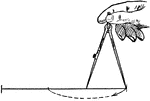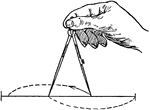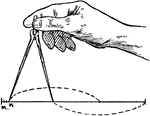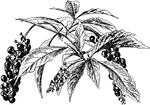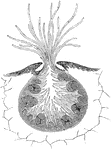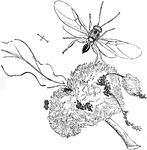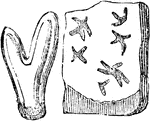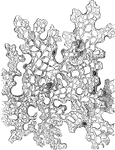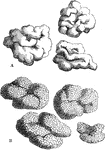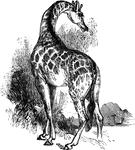
Trunk of the Meat-Fly
"The trunk appears to be composed of two parts, joined, and forming a more or less obtuse angle."
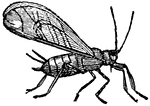
Winged Aphides, or Plant Lice
"They subsist on the sap of the tree; and are sometimes provided with wings, and are sometimes without."

Winged Aphides, or Plant Lice
"They subsist on the sap of the tree; and are sometimes provided with wings, and are sometimes without."

Wingless Aphides, or Plant Lice
"They subsist on the sap of the tree; and are sometimes provided with wings, and are sometimes without."
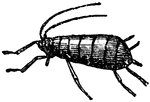
Wingless Aphides, or Plant Lice
"They subsist on the sap of the tree; and are sometimes provided with wings, and are sometimes without."

Ant and Plant Lice
Ants are very fond of a sugary liquid that Plant lice secrete. They will milk the bugs of this liquid.
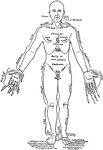
Front View of the Parts of the Human Body Labeled in English and Latin
Front view of a man in the anatomical position. On one lateral half the parts are labeled in English,…

Back View of the Parts of the Human Body Labeled in English and Latin
Back view of a man. On one lateral the names of the parts are given in English, on the other in Latin.
Gastropulmonary Mucous Membrane
Diagram of the gastropulmonary mucous membrane, showing the continuity of all its parts.

Angular Pupa of a Butterfly
"The head of the angular pupae terminates sometimes in two angular parts, which diverge from each other…
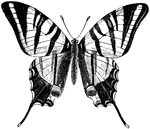
The Scarce Swallow Tailed Butterfly (Papilio Podalirius)
Its lower wings have tails longer and narrower than the standard Swallow Tailed Butterfly. This species…
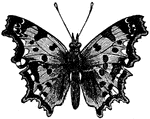
The Comma Butterfly (Vanessa C. Album)
"The Comma Butterfly is common, especially in many parts of England. Its caterpillar lives on the nettle,…
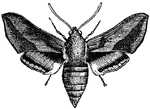
Deilephila Euphorbiae
This butterfly may be found "on the continent of Europe, during the months of June and September, and…

Bloodroot flower
"Nature, pervades the air, where grow the modest blue-eyed violets, the fragrant trailing arbutus, spicy…
Longleaf Pine (Pinus palustris Mill.). Two-thirds natural size. epidermis of leaf (magnified)
The longleaf pine commonly found in the South Atlantic and Gulf States. The leaves are 9 to 12 inches…

Shortleaf pine (pinus echinata Mill.). Natural size. branch with open cones
The shortleaf pine is mostly associated with with deciduous-leaved trees, often the predominant forest…

Shortleaf pine (pinus echinata Mill.). Natural size. cone scales, dorsal view
The shortleaf pine is mostly associated with with deciduous-leaved trees, often the predominant forest…

Shortleaf pine (pinus echinata Mill.). Natural size. cone scales, ventral view
The shortleaf pine is mostly associated with with deciduous-leaved trees, often the predominant forest…

Shortleaf pine (pinus echinata Mill.). Natural size. seed
The shortleaf pine is mostly associated with with deciduous-leaved trees, often the predominant forest…

Mesquit (prosopis juliflora).
The mesquit is on of the characteristic shrubs throughout the desert. It varies in size from a straggling…

Spanish bayonet (yucca baccata).
Two or three species of yucca are called Spanish bayonet. The shrub has a thick stalk about 3 or 4 feet…

Creosote bush (larrea mexicana)
The creosote is a sticky, resinous bush with small round evergreen leaves, yellow flowers, woolly fruit,…

Candlewood (fouquiera splendens).
The candlewood consists of about a dozen stalks about an inch in diameter, nearly straight, and about…
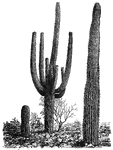
Giant Cactus (cereus giganteus).
The giant cactus is by far the largest form of vegetation in the desert. They can grow to be over 20…

Broomrape (orobanche ramosa).
An annual plant , 6 to 15 inches high, with many slender branches of a brownish or straw color, more…

Brown Alga
"Fucus platycarpus...3. jointed branching hairs detached from the sides of the conceptacle and bearing…

Common Stonewort
"1. Chara vulgaris; 2. a portion of a branch with a nucule and globule; 3. the globule more magnified;…
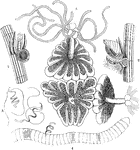
Chara fragilis
"1. Antherid and spore-case of Chara fragilis not much magnified; 2. the same at a later period, after…

Arcyria flava
Arcyria flava (or Arcyria obvelata) is a species of fungus or slime mold found in Australia.

Mucor caninus
Mucor caninus is a species of mold found in soil, on plant surfaces, and rotting vegetables.
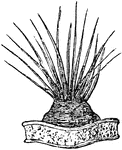
Fungal Disease
Vermicularia trichella is a fungal plant disease that causes leaf and stem spot in English Ivy.
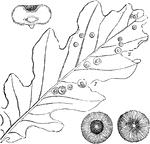
Fungal Diseas
"Mucor mucedo, very highly magnified, exhibiting 1, the spawn or mycelium." -Lindley, 1853

Cordycep
The Sphaeria sinensis a cordycep, a parasitic fungus. "The right hand figure represents the manner in…

Cordycep
The Sphaeria Robertsii a cordycep, a parasitic fungus "growing from the caterpillar of a New Zealand…

Flocci and Spores
"1. Polyplocium inquinans, divided vertically, natural size; 2. flocci and spores; 3 and 4, the same…

Fungus
"Pisomyxa racodioides, Corda.-1. Natural size; 2, the fungus greatly magnified; 3, a spore-case bursting…

Ground Pine
"1. Spore-case of Lycopodium denticulatum opened; 2. antheridium; 3. spore." -Lindley, 1853

Lichen
"1. Shields of Variolaria amara; 2, a portion of the thallus of the same plant." -Lindley, 1853

Tree Lungwort
"3. a piece of the thallus of Sticta pulmonacea, with lacunae and soredia; 4. thallus of the same, bearing…
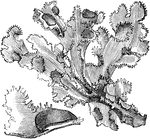
Iceland Moss
"Cetraria islandica: a a. its shields; b. a shield magnified and divided vertically." -Lindley, 1853

Leaf Lichen
"A greatly magnified view of a perpendicular section of Parmelia aipolia, showing the thecae in the…
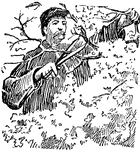
Pruning
Pruning in landscaping and gardening is the practice of removing diseased, non-productive, or otherwise…
